GMC SAVANA 2007 Owner's Manual
Manufacturer: GMC, Model Year: 2007, Model line: SAVANA, Model: GMC SAVANA 2007Pages: 452, PDF Size: 2.68 MB
Page 161 of 452
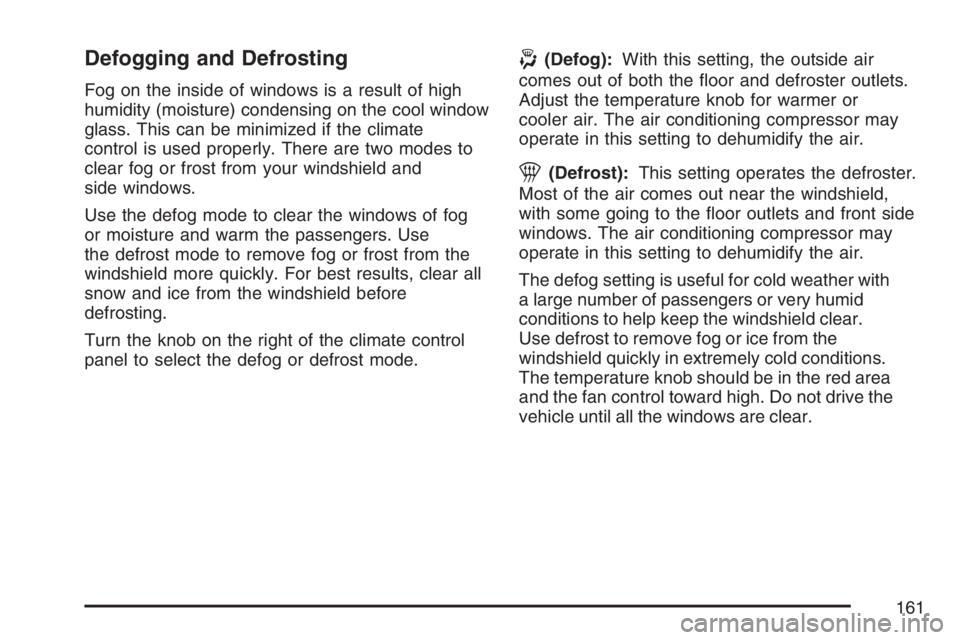
Defogging and Defrosting
Fog on the inside of windows is a result of high
humidity (moisture) condensing on the cool window
glass. This can be minimized if the climate
control is used properly. There are two modes to
clear fog or frost from your windshield and
side windows.
Use the defog mode to clear the windows of fog
or moisture and warm the passengers. Use
the defrost mode to remove fog or frost from the
windshield more quickly. For best results, clear all
snow and ice from the windshield before
defrosting.
Turn the knob on the right of the climate control
panel to select the defog or defrost mode.
-(Defog):With this setting, the outside air
comes out of both the floor and defroster outlets.
Adjust the temperature knob for warmer or
cooler air. The air conditioning compressor may
operate in this setting to dehumidify the air.
1(Defrost):This setting operates the defroster.
Most of the air comes out near the windshield,
with some going to the floor outlets and front side
windows. The air conditioning compressor may
operate in this setting to dehumidify the air.
The defog setting is useful for cold weather with
a large number of passengers or very humid
conditions to help keep the windshield clear.
Use defrost to remove fog or ice from the
windshield quickly in extremely cold conditions.
The temperature knob should be in the red area
and the fan control toward high. Do not drive the
vehicle until all the windows are clear.
161
Page 162 of 452
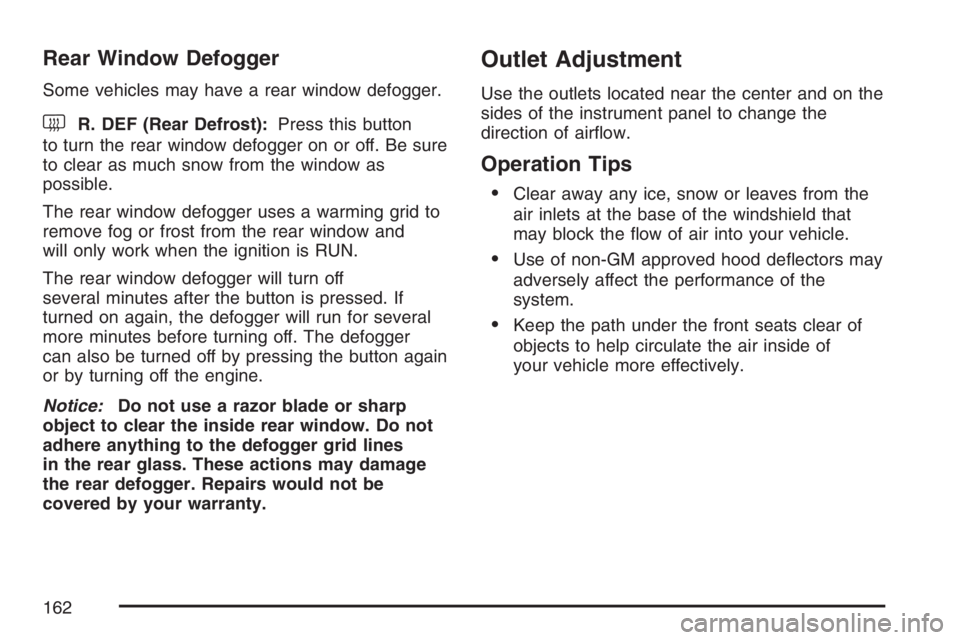
Rear Window Defogger
Some vehicles may have a rear window defogger.
to clear as much snow from the window as
possible.
The rear window defogger uses a warming grid to
remove fog or frost from the rear window and
will only work when the ignition is RUN.
The rear window defogger will turn off
several minutes after the button is pressed. If
turned on again, the defogger will run for several
more minutes before turning off. The defogger
can also be turned off by pressing the button again
or by turning off the engine.
Notice:Do not use a razor blade or sharp
object to clear the inside rear window. Do not
adhere anything to the defogger grid lines
in the rear glass. These actions may damage
the rear defogger. Repairs would not be
covered by your warranty.
Outlet Adjustment
Use the outlets located near the center and on the
sides of the instrument panel to change the
direction of airflow.
Operation Tips
•Clear away any ice, snow or leaves from the
air inlets at the base of the windshield that
may block the flow of air into your vehicle.
•Use of non-GM approved hood deflectors may
adversely affect the performance of the
system.
•Keep the path under the front seats clear of
objects to help circulate the air inside of
your vehicle more effectively.
162
Page 163 of 452
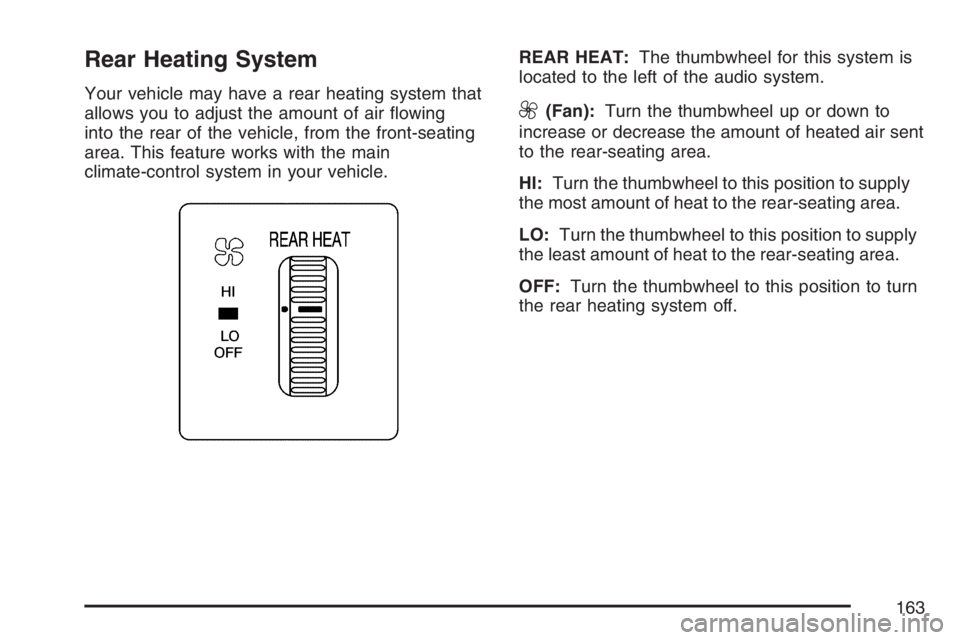
Rear Heating System
Your vehicle may have a rear heating system that
allows you to adjust the amount of air flowing
into the rear of the vehicle, from the front-seating
area. This feature works with the main
climate-control system in your vehicle.REAR HEAT:The thumbwheel for this system is
located to the left of the audio system.9(Fan):Turn the thumbwheel up or down to
increase or decrease the amount of heated air sent
to the rear-seating area.
HI:Turn the thumbwheel to this position to supply
the most amount of heat to the rear-seating area.
LO:Turn the thumbwheel to this position to supply
the least amount of heat to the rear-seating area.
OFF:Turn the thumbwheel to this position to turn
the rear heating system off.
163
Page 164 of 452
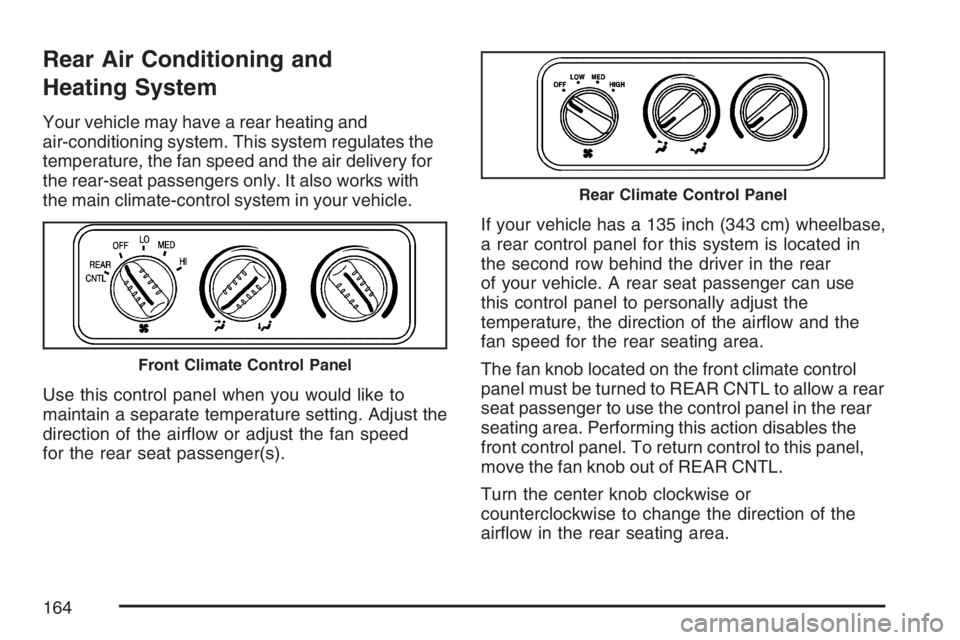
Rear Air Conditioning and
Heating System
Your vehicle may have a rear heating and
air-conditioning system. This system regulates the
temperature, the fan speed and the air delivery for
the rear-seat passengers only. It also works with
the main climate-control system in your vehicle.
Use this control panel when you would like to
maintain a separate temperature setting. Adjust the
direction of the airflow or adjust the fan speed
for the rear seat passenger(s).If your vehicle has a 135 inch (343 cm) wheelbase,
a rear control panel for this system is located in
the second row behind the driver in the rear
of your vehicle. A rear seat passenger can use
this control panel to personally adjust the
temperature, the direction of the airflow and the
fan speed for the rear seating area.
The fan knob located on the front climate control
panel must be turned to REAR CNTL to allow a rear
seat passenger to use the control panel in the rear
seating area. Performing this action disables the
front control panel. To return control to this panel,
move the fan knob out of REAR CNTL.
Turn the center knob clockwise or
counterclockwise to change the direction of the
airflow in the rear seating area.
Front Climate Control Panel
Rear Climate Control Panel
164
Page 165 of 452
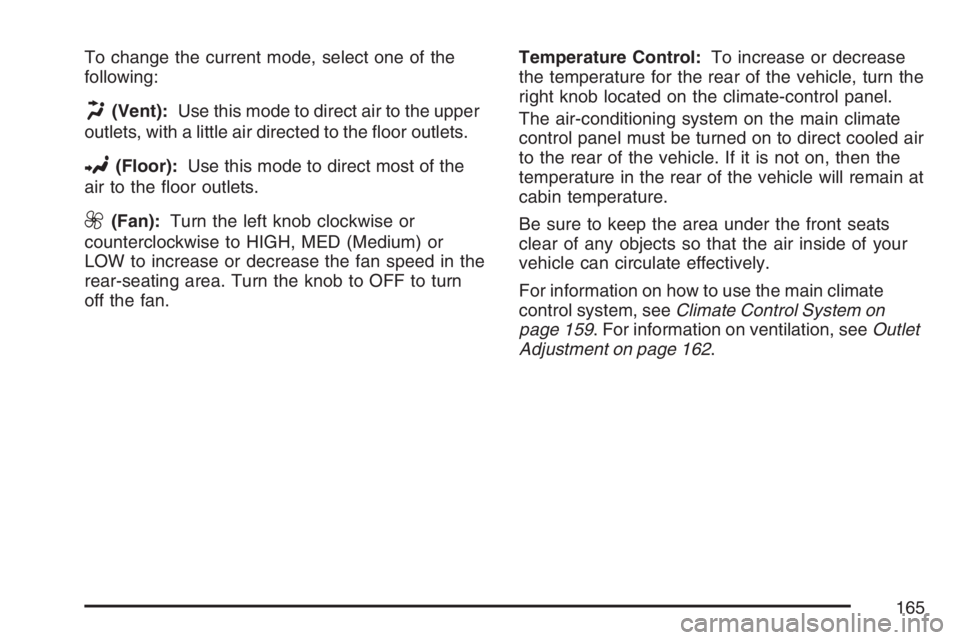
To change the current mode, select one of the
following:
H(Vent):Use this mode to direct air to the upper
outlets, with a little air directed to the floor outlets.
2(Floor):Use this mode to direct most of the
air to the floor outlets.
9(Fan):Turn the left knob clockwise or
counterclockwise to HIGH, MED (Medium) or
LOW to increase or decrease the fan speed in the
rear-seating area. Turn the knob to OFF to turn
off the fan.Temperature Control:To increase or decrease
the temperature for the rear of the vehicle, turn the
right knob located on the climate-control panel.
The air-conditioning system on the main climate
control panel must be turned on to direct cooled air
to the rear of the vehicle. If it is not on, then the
temperature in the rear of the vehicle will remain at
cabin temperature.
Be sure to keep the area under the front seats
clear of any objects so that the air inside of your
vehicle can circulate effectively.
For information on how to use the main climate
control system, seeClimate Control System on
page 159. For information on ventilation, seeOutlet
Adjustment on page 162.
165
Page 166 of 452
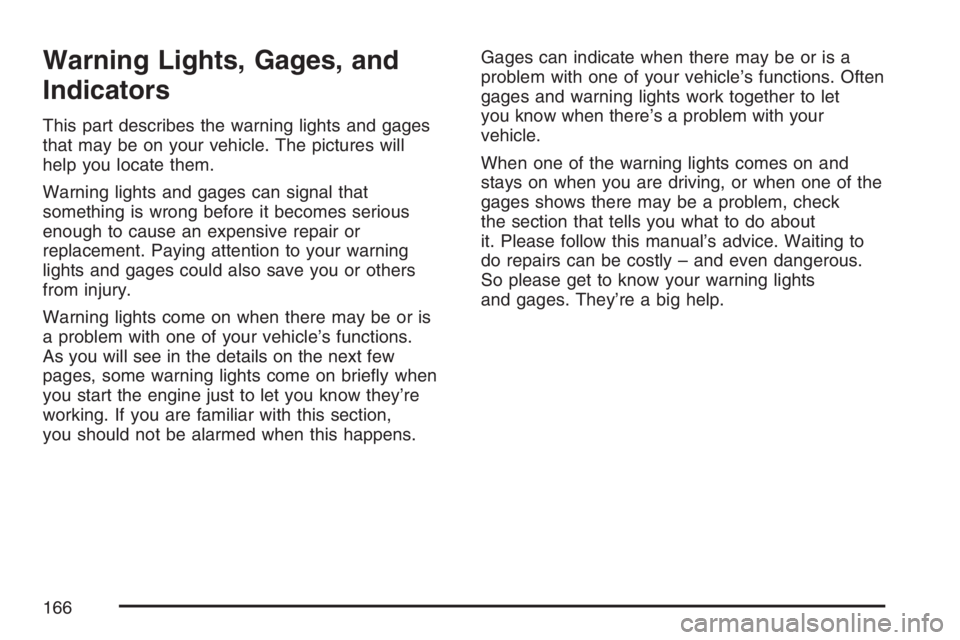
Warning Lights, Gages, and
Indicators
This part describes the warning lights and gages
that may be on your vehicle. The pictures will
help you locate them.
Warning lights and gages can signal that
something is wrong before it becomes serious
enough to cause an expensive repair or
replacement. Paying attention to your warning
lights and gages could also save you or others
from injury.
Warning lights come on when there may be or is
a problem with one of your vehicle’s functions.
As you will see in the details on the next few
pages, some warning lights come on briefly when
you start the engine just to let you know they’re
working. If you are familiar with this section,
you should not be alarmed when this happens.Gages can indicate when there may be or is a
problem with one of your vehicle’s functions. Often
gages and warning lights work together to let
you know when there’s a problem with your
vehicle.
When one of the warning lights comes on and
stays on when you are driving, or when one of the
gages shows there may be a problem, check
the section that tells you what to do about
it. Please follow this manual’s advice. Waiting to
do repairs can be costly – and even dangerous.
So please get to know your warning lights
and gages. They’re a big help.
166
Page 167 of 452

Instrument Panel Cluster
The instrument panel cluster is designed to let you know at a glance how the vehicle is running.
You will know how fast you are going, how much fuel you are using, and many other things you will
need to know to drive safely and economically.
United States version shown, Canada similar
167
Page 168 of 452
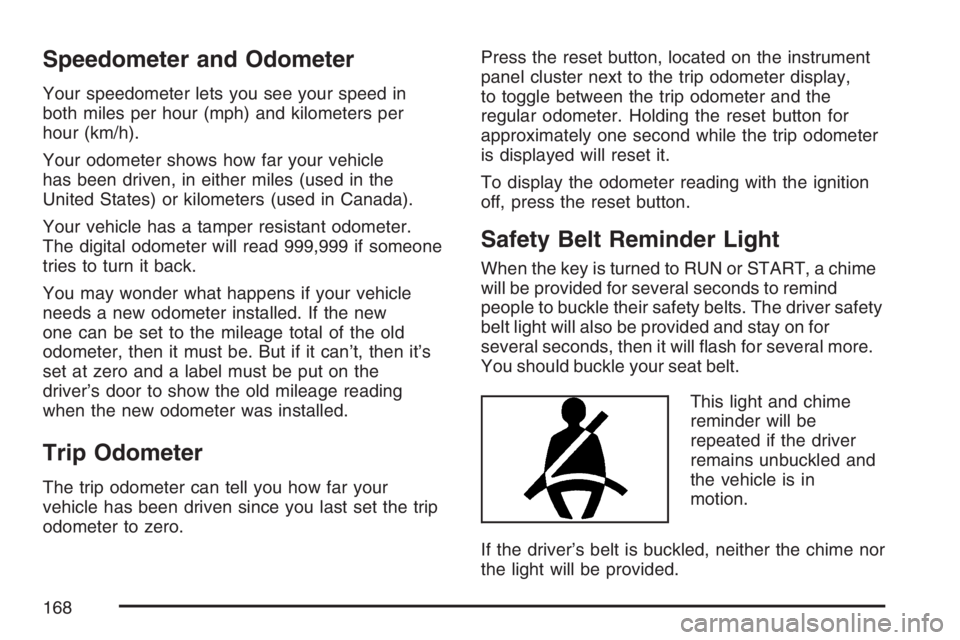
Speedometer and Odometer
Your speedometer lets you see your speed in
both miles per hour (mph) and kilometers per
hour (km/h).
Your odometer shows how far your vehicle
has been driven, in either miles (used in the
United States) or kilometers (used in Canada).
Your vehicle has a tamper resistant odometer.
The digital odometer will read 999,999 if someone
tries to turn it back.
You may wonder what happens if your vehicle
needs a new odometer installed. If the new
one can be set to the mileage total of the old
odometer, then it must be. But if it can’t, then it’s
set at zero and a label must be put on the
driver’s door to show the old mileage reading
when the new odometer was installed.
Trip Odometer
The trip odometer can tell you how far your
vehicle has been driven since you last set the trip
odometer to zero.Press the reset button, located on the instrument
panel cluster next to the trip odometer display,
to toggle between the trip odometer and the
regular odometer. Holding the reset button for
approximately one second while the trip odometer
is displayed will reset it.
To display the odometer reading with the ignition
off, press the reset button.
Safety Belt Reminder Light
When the key is turned to RUN or START, a chime
will be provided for several seconds to remind
people to buckle their safety belts. The driver safety
belt light will also be provided and stay on for
several seconds, then it will flash for several more.
You should buckle your seat belt.
This light and chime
reminder will be
repeated if the driver
remains unbuckled and
the vehicle is in
motion.
If the driver’s belt is buckled, neither the chime nor
the light will be provided.
168
Page 169 of 452
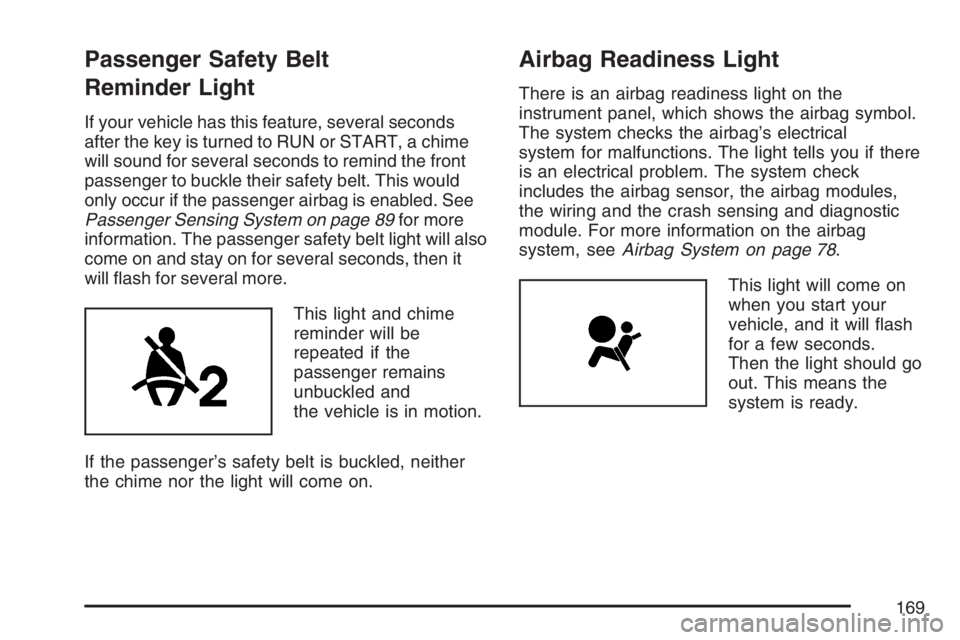
Passenger Safety Belt
Reminder Light
If your vehicle has this feature, several seconds
after the key is turned to RUN or START, a chime
will sound for several seconds to remind the front
passenger to buckle their safety belt. This would
only occur if the passenger airbag is enabled. See
Passenger Sensing System on page 89for more
information. The passenger safety belt light will also
come on and stay on for several seconds, then it
will flash for several more.
This light and chime
reminder will be
repeated if the
passenger remains
unbuckled and
the vehicle is in motion.
If the passenger’s safety belt is buckled, neither
the chime nor the light will come on.
Airbag Readiness Light
There is an airbag readiness light on the
instrument panel, which shows the airbag symbol.
The system checks the airbag’s electrical
system for malfunctions. The light tells you if there
is an electrical problem. The system check
includes the airbag sensor, the airbag modules,
the wiring and the crash sensing and diagnostic
module. For more information on the airbag
system, seeAirbag System on page 78.
This light will come on
when you start your
vehicle, and it will flash
for a few seconds.
Then the light should go
out. This means the
system is ready.
169
Page 170 of 452
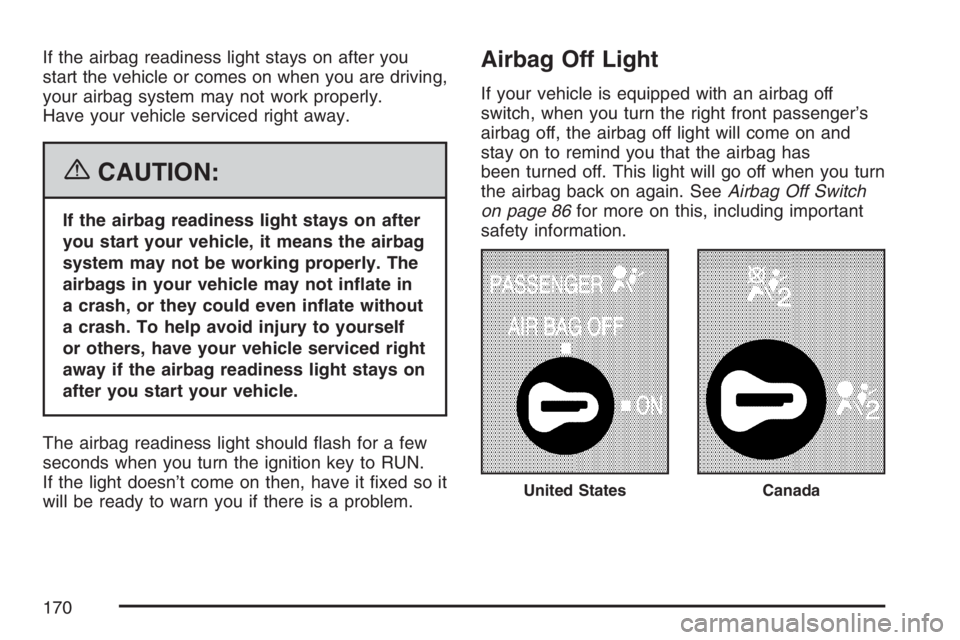
If the airbag readiness light stays on after you
start the vehicle or comes on when you are driving,
your airbag system may not work properly.
Have your vehicle serviced right away.
{CAUTION:
If the airbag readiness light stays on after
you start your vehicle, it means the airbag
system may not be working properly. The
airbags in your vehicle may not in�ate in
a crash, or they could even in�ate without
a crash. To help avoid injury to yourself
or others, have your vehicle serviced right
away if the airbag readiness light stays on
after you start your vehicle.
The airbag readiness light should flash for a few
seconds when you turn the ignition key to RUN.
If the light doesn’t come on then, have it fixed so it
will be ready to warn you if there is a problem.
Airbag Off Light
If your vehicle is equipped with an airbag off
switch, when you turn the right front passenger’s
airbag off, the airbag off light will come on and
stay on to remind you that the airbag has
been turned off. This light will go off when you turn
the airbag back on again. SeeAirbag Off Switch
on page 86for more on this, including important
safety information.
United StatesCanada
170